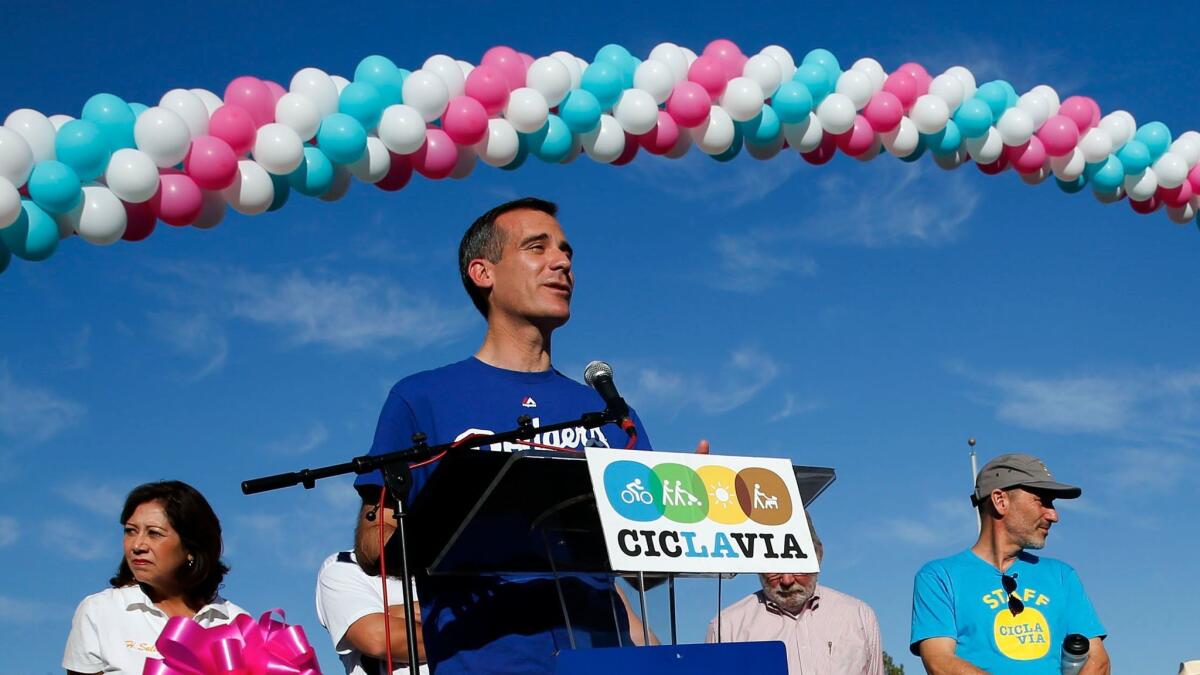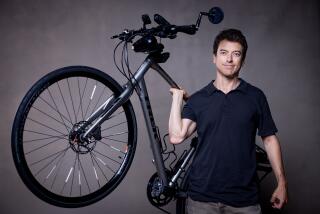Opinion: L.A. has seen too much talk and not enough action from Mayor Eric Garcetti on making our streets safer

Itâs no secret that Los Angeles has some of the most dangerous streets in America. More than 200 people die in traffic crashes each year in L.A., which has one of the highest rates of pedestrian fatalities among major U.S. cities. Overall traffic fatalities are on the rise, with pedestrians and cyclists disproportionately representing 53% of those killed. The majority of this tragic burden is borne by lower-income communities, school children, and the elderly, who frequently lack access to cars and are dependent on transit and bike travel.
In response to these needless deaths, L.A.âs political leadership has spent years generating an abundance of visionary plans aimed at making our streets safer for everyone who uses them. In 2011, the City Council passed an ambitious Bicycle Master Plan, which called for the the annual installation of 80 bike lane miles. They followed it up in 2015 with a visionary, âsafety-firstâ Mobility Plan, which called for the construction of 300 lane miles of protected bikeways over 20 years. The city also adopted a Vision Zero Policy, targeting 450 miles of L.A.âs most dangerous roadways, with the ultimate goal of eliminating traffic deaths in the city by 2025.
These plans all have their merits. When it comes to actually making the tough political decisions needed to implement them, however, our leadership has been lacking â particularly from Mayor Eric Garcetti.
After a few years of scattered bicycle safety improvements under former Mayor Antonio Villaraigosa â peaking at 251 bike lane miles installed in 2012-13 â L.A.âs pace has slowed considerably since Garcetti took office. Only 17 bike lane miles were installed in 2015-16.
This slowdown on bike lanes is only a small example of how our mayor has struggled to turn long-planned concepts into action.
To get an idea of the problem, itâs useful to look at what other big cities have done. In Chicago, Mayor Rahm Emanuel rapidly rolled out more than 100 miles of protected bike lanes in his first term. In New York, former Mayor Michael Bloomberg implemented extensive life-saving traffic safety improvements across the city, including a cohesive bike lane network and a massive pedestrian-oriented transformation of Times Square.
Garcetti, meanwhile, in making his case as a champion for safer streets, has pointed toward Vision Zeroâs goal of eliminating traffic-related deaths. That plan, however, fails to prioritize building the types of infrastructure changes needed to address automobile speeding â a primary cause of deadly crashes. Street reconfigurations called âroad diets,â which remove traffic lanes and give added weight to bikes and pedestrians, as well as the creation of connected bike lane networks, are nationally recognized as the best techniques to address deadly speeding.
In lieu of these, the cityâs plan places most of the burden of reducing speeding on law enforcement, an inequitable and inefficient solution that fails to make L.A. a safer or more pleasant place to walk or bike.
Remaking our streets will be politically challenging. The uproar over the demonstrably successful 2013 Rowena Avenue road diet was a stark reminder that L.A.âs entrenched automobile-first culture will not go quietly. Small, piecemeal changes, however, accomplish little.
All of this is particularly distressing because of the critical juncture at which L.A. currently finds itself. After passing Measure M in November, Los Angeles County is poised to invest $120 billion in expanding public transit and street upgrades. But transit can become a viable alternative to driving only if people can safely walk and bike to bus stops and rail stations. As we approach the March 7 primary election, L.A. is faced with a choice between supporting the safety of all residents, or continuing to be defined by our sprawling, congested and dangerous streets, while saddled with an expensive but underused transit system.
Unfortunately, other mayoral candidates in the upcoming election have little more to offer than Garcetti. Mitchell Schwartz, the mayorâs best-financed opponent, has only vague ideas for improving safety.
If Garcetti is truly committed to eliminating traffic-related deaths, he will need to spend political capital to make it happen. In New York, Bloomberg empowered transportation commissioner Janette Sadik-Khan to make sweeping transformations to prioritize safety leading to as much as 67% reductions in dangerous crashes, significant increases in retail sales, and a near doubling of bicycle commuters. Garcetti should give LADOT general manager Seleta Reynolds the same mandate.
Additionally, he will need to transform the hidebound Department of Public Works and its various bureaus, whose old-fashioned approach to street design often prioritizes vehicle speed at the expense of safety. He will need to move beyond celebrating small pilot projects, and start pushing for an extensive network of family-friendly protected bike lanes, while ensuring that LADOT is adequately funded and staffed to get the job done.
Garcetti clearly understands the health, equity, quality of life, and economic benefits of making city streets safer for all. If he earns a second term as mayor, Angelenos deserve a more impassioned and resourceful effort to build a healthier, more sustainable, and more livable city.
Michael MacDonald is a Los Angeles-based architect and a steering committee member of Bike the Vote L.A. Follow Bike the Vote on Twitter at @bikethevote.
Follow the Opinion section on Twitter @latimesopinion or Facebook
More to Read
A cure for the common opinion
Get thought-provoking perspectives with our weekly newsletter.
You may occasionally receive promotional content from the Los Angeles Times.










